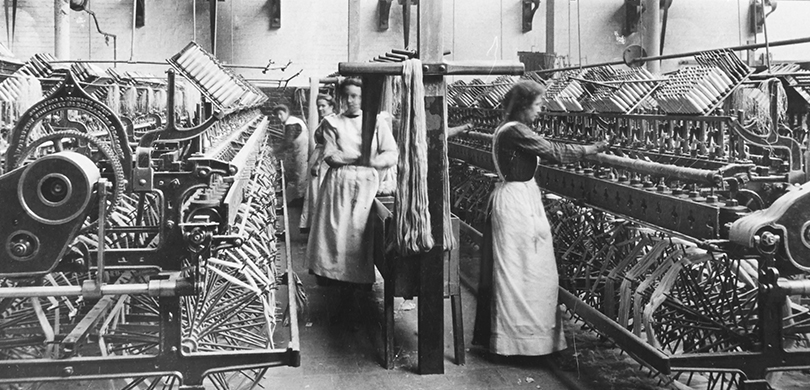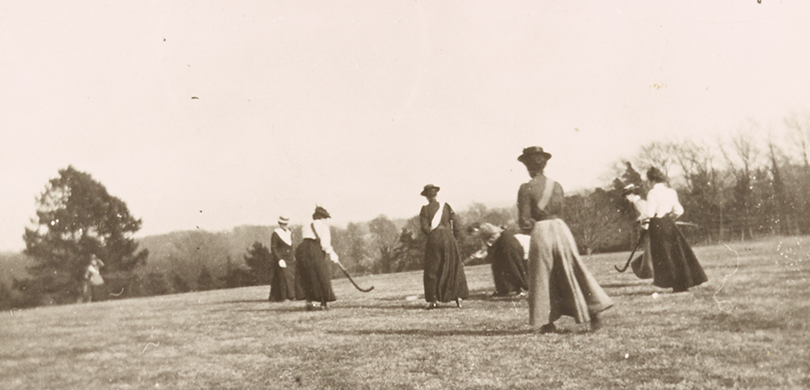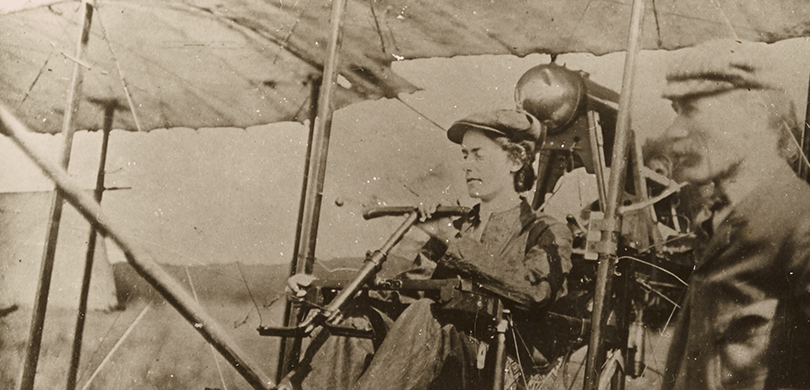Introduction
The first decade of the 20th century saw the beginnings of involvement by Irish women on a wide range of issues – campaigning for women’s education, forming organisations to fight for women’s suffrage, encouraging women into trade unions, and organising for and against home rule for Ireland. Many of the women who became activists in these years would continue their work in the following decade, some serving prison sentences for their suffrage activities, others helping the war effort during the First World War or participating in the Easter Rising.
Context:
The movement for votes for women had begun in Ireland with the formation of the North of Ireland Society for Women’s Suffrage by Isabella Tod in Belfast in 1871. It later became known as the Irish Women’s Suffrage Society. The Irishwomen’s Suffrage and Local Government Association was formed by Thomas and Anna Haslam in Dublin in 1876. The passing of the Poor Law Guardian (Ireland) (Women) Act of 1896 facilitated women’s formal participation in important aspects of the administration of indoor relief in their localities. The Boards of Guardians onto which they were elected were responsible for workhouses, fever hospitals and infirmaries, and provided valuable experience in civic responsibilities formerly confined to philanthropic endeavours. The first woman guardian, Miss E.Martin, was co-opted in Lisnaskea in 1896. Between then and 1940, a total of 173 women were elected to serve in this capacity, constituting 67% of women’s total municipal representation. Few were feminists, but in 1908 Ethel Macnaghten, founder of Bushmills Suffrage Society, was co-opted onto the Belfast board and two members of the Irish Women’s Suffrage Society, Frances Reid and Annie Entrican, became poor law guardians in Belfast.
The Local Government (Ireland) Act of 1898 opened up local government to women, although they were not able to stand for county borough councils until 1911. In the 1902 local government elections, four women were elected but women’s representation on local government bodies remained very small, averaging just 1.4% of the total council positions in Ulster between 1898 and1940.
In 1859, Margaret Byers established The Ladies Collegiate School, which was the first academic school for girls in the north. In 1887, the year of Queen Victoria’s Royal Jubilee, it was renamed Victoria College. In 1869, Byers successfully petitioned Queen’s College to allow her pupils to take their exams and in 1908, women were finally able to attend what had become Queen’s University of Belfast on the same basis as men. That year Byers was appointed to the senate of Queen’s in recognition of her work for women’s education.
Mary Galway, from Springfield Road Belfast, was appointed organising secretary for the Irish Textile Operative’s Union in 1897, the first woman to hold such a position in the Irish trade union movement. She addressed rallies and collected funds during the Belfast dockers’ and carters’ strike of 1907. She was an active member of the executive of the Belfast Trades Council and was elected Vice President of the Irish Trade Union Congress in 1910.
Nationalist women in the north had been active in a number of initiatives in the late 19th century, in the Irishwomen’s Centenary Union commemorating the centenary of the 1798 United Irish rising and in the Gaelic League. Anna Johnson and Alice Milligan were editors of the nationalist journal Shan Van Vocht, which was produced in Belfast between 1896-1899 and both women were strong supporters of Maud Gonne and the Inghinidhe na hEireann. The Gaelic League attracted large numbers of young men and women to its ranks, many of whom would go on to become active in nationalist organisations when the home rule crisis began.
The textile industry was a major employer of women, with the linen industry in the north being the largest in the world at this time. In 1901, there were 188,000 females and 162,000 males employed in the textile industry and allied trades in Belfast. Children were also employed, with more than 3,000 half-timers in Belfast (beginning work at the age of 13) employed in 1907. In addition to factory work, many were employed as outworkers. Hilda Martindale, ‘lady factory inspector’, in England was appointed full-time factory inspector for Ireland in 1905, based in Belfast with an office in Donegall Street and travelling 10,000 miles a year around the country. She stayed until 1912. Child employment was one issue she reported on: ‘In the counties of Antrim and Down out of 50,686 persons employed in textile factories, practically all in flax spinning and weaving, 13,691 were under 18 years of age; and out of this number 4,144 were half-timers from 12-14 years…In Belfast the half-timers were usually employed on the alternate day system, the hours being 6.30 am to 6pm…according to the census of 1901 in Belfast, out of 63,879 children 11,037 children were entered as unable to read or write.’ In the Lurgan area she reported on boys and girls employed in their own homes, preparing handkerchiefs for hem stitching, ‘in some streets one could hardly enter a house without seeing 2, 3, 4 or more children, varying in age from 6 to 12 years, sitting around a table all intensely busy trying to earn a miserable pittance.’ Most were working 4-5 hours a day, if not longer. One problem was the low rate of pay for women, which meant they had no choice but to send their children out to work.
Timeline:
1900
- Inghinidhe na hEireann (Daughters of Ireland), a nationalist-feminist group has its inaugural meeting in Dublin in October. Maud Gonne is President and Anna Johnson from Belfast, who together with Alice Milligan had edited the Belfast nationalist paper Shan Van Vocht (1896-1899), was one of the vice-presidents. A short-lived Belfast branch was formed in 1903.
1902
- Four women elected on rural district councils in the north in Ballymoney, Coleraine, Limavady (2).
1905
- Hilda Martindale comes to Ireland as the first woman inspector of factories.Florence Hobson (sister of Bulmer Hobson, northern organiser for the Irish Republican Brotherhood) becomes the first woman architect in Ireland and is appointed to assist the Royal Commission on the City of Belfast’s Health and Housing.
1906
- Women spinners from York Street and Falls Road go on strike and win wage claim.
1907
- Women from Gallaher’s factory march in support of the dockers.
1908
- University Act 1908 gives women the right to full attendance at university. Margaret Byers is elected to the Senate of Queen’s College in recognition of her campaigning work for women’s right to university education.Old Age Pensions Act: means-tested, non-contributory pensions are introduced for people over 70.
1909
- Irish Women’s Suffrage Society, based in Donegall Place, forms branches in Whitehead, Derry and Bangor.
1910
- Emmeline Pankhurst speaks at suffrage meetings in Dundalk, Belfast, Derry, Cork and Dublin.
Mary Galway of the Irish Textile Operative’s Union elected vice-president of the Irish Congress of Trade Unions.Lilian Bland, journalist and aviator, becomes the first woman to design, build and fly an aircraft in Ireland by flying a glider (the Mayfly) on Carnmoney Hill.
At an International Conference of Working Women in Copenhagen with 100 women representing 17 countries, Clara Zetkin proposes the idea of an International Women Day. As a result, International Women’s Day celebrations begin in 1911.
FURTHER READING:
Angela Bourke (ed), The Field Day Anthology of Irish Literature: Irish Women's Writing and Traditions: Vol V (Cork: Cork University Press, 2002).
Myrtle Hill, Women in Ireland: a century of change (Belfast: Blackstaff Press, 2003).
Hilda Martindale, From One Generation to Another 1839-1944 (London, Allen and Unwin, 1944).
‘Theresa Moriarty, ‘Mary Galway’ in Female Activists – Irish Women and Change (1900-1960), Mary Cullen and Maria Luddy (eds) (Dublin: the Woodfield Press, 2001).
Sheila Johnston, Alice – A Life of Alice Milligan (Belfast: Counterpoint Books, 1994).
Catherine Morris, Alice Milligan and the Irish Cultural Revival (Dublin: Four Courts Press, 2012).
Henry Patterson, ‘Industrial Labour and the Labour Movement, 1820-1914’, in Liam Kennedy, Philip Ollerenshaw (eds), An Economic History of Ulster 1920-1939 (Manchester 1985), pp. 158-183.
Diane Urquhart, Women in Ulster Politics 1890-1940 (Dublin: Irish Academic Press, 2000).
Margaret Ward, Unmanageable Revolutionaries: women and Irish nationalism (London: Pluto Press, 1983).
Helga Woggon, Ellen Grimley (Nellie Gordon) – Reminiscences of her work with James Connolly in Belfast, (Dublin: SIPTU, 2000).


